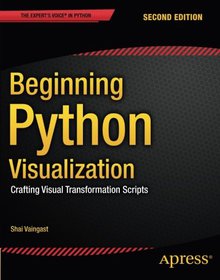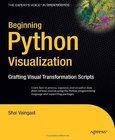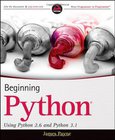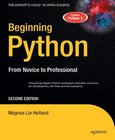Beginning Python Visualization
Crafting Visual Transformation Scripts
2nd Edition

Book Details:
| Publisher: | Apress |
| Series: | Apress , Beginning |
| Author: | Shai Vaingast |
| Edition: | 2 |
| ISBN-10: | 1484200535 |
| ISBN-13: | 9781484200537 |
| Pages: | 416 |
| Published: | Aug 19 2014 |
| Posted: | Nov 19 2014 |
| Language: | English |
| Book format: | |
| Book size: | 7.04 MB |
Book Description:
We are visual animals. But before we can see the world in its true splendor, our brains, just like our computers, have to sort and organize raw data, and then transform that data to produce new images of the world. Beginning Python Visualization: Crafting Visual Transformation Scripts, Second Edition discusses turning many types of data sources, big and small, into useful visual data. And, you will learn Python as part of the bargain.In this second edition you'll learn about Spyder, which is a Python IDE with MATLAB -like features. Here and throughout the book, you'll get detailed exposure to the growing IPython project for interactive visualization. In addition, you'll learn about the changes in NumPy and Scipy that have occurred since the first edition. Along the way, you'll get many pointers and a few visual examples. As part of this update, you'll learn about matplotlib in detail; this includes creating 3D graphs and using the basemap package that allows you to render geographical maps. Finally, you'll learn about image processing, annotating, and filtering, as well as how to make movies using Python. This includes learning how to edit/open video files and how to create your own movie, all with Python scripts. Today's big data and computational scientists, financial analysts/engineers and web developers like you - will find this updated book very relevant. What youll learnHow to present visual information instead of data soupHow to set up an open source environment ready for data visualizationHow to do numerical and textual processingHow to draw graphs and plots based on textual and numerical data using NumPy, Spyder and moreHow to explore and use new visual libraries including matplotlib's 3D graphs and basemap packageHow to build and use interactive visualization using IPythonWho this book is for IT personnel, programmers, engineers, and hobbyists interested in acquiring and displaying data from the Web, sensors, economic trends, and even astronomical sources. Table of Contents1. Navigating the World of Data Visualization2. The Environment3. Python for Programmers4. Data Organization5. Processing Text Files6. Graphs and Plots7. Math Games8. Business and Visualization9. Image Processing10. Advanced File Processing11. Appendix
Download Link:
Related Books:
Beginning Python Visualization
Crafting Visual Transformation Scripts
We are visual animals. But before we can see the world in its true splendor, our brains, just like our computers, have to sort and organize raw data, and then transform that data to produce new images of the world. Beginning Python Visualization: Crafting Visual Transformation Scripts discusses turning many types of small data sources into useful visual data. And, you will learn Python as part of the bargain....
Beginning Python
Using Python 2.6 and Python 3.1
Beginning Python: Using Python 2.6 and Python 3.1 introduces this open source, portable, interpreted, object-oriented programming language that combines remarkable power with clear syntax. This book enables you to quickly create robust, reliable, and reusable Python applications by teaching the basics so you can quickly develop Web and scientific applications, incorporate databases, and master systems tasks on various operating systems, including Linux, MAC OS, and Windows. You'll get a comprehensive tutorial that guides you from writing simple, basic Python scripts all the way through complex concepts, and also features a reference of the standard modules with examples illustrating how to implement features in the various modules. Plus, the book cov...
Beginning Python
From Novice to Professional
2nd Edition
Gain a fundamental understanding of Pythons syntax and features with the second edition of Beginning Python, an uptodate introduction and practical reference. Covering a wide array of Pythonrelated programming topics, including addressing language internals, database integration, network programming, and web services, youll be guided by sound development principles. Ten accompanying projects will ensure you can get your hands dirty in no time. Updated to reflect the latest in Python programming paradigms and several of the most crucial features found in Python 3.0 (otherwise known as Python 3000), advanced topics, such as extending Python and packaging...
2007 - 2021 © eBooks-IT.org



